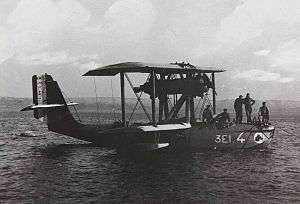CAMS 51
| 51 | |
|---|---|
 | |
| Role | Transport and patrol flying boat |
| Manufacturer | CAMS |
| Designer | Maurice Hurel |
| First flight | 1926 |
| Number built | 3 |
|
| |
The CAMS 51 was a transport flying boat built in France in the mid-1920s. Designed as a private venture by Chantiers Aéro-Maritimes de la Seine (CAMS), it was a conventional biplane with two radial engines mounted in a tractor-pusher installation in the interplane gap. One example (the 51C) was sold to Aéropostale, which used it for tests in preparation for transatlantic services. CAMS also built a militarised version as the 51R3 in the hopes of interesting the French Navy in it as a reconnaissance aircraft, but no order was forthcoming. A final aircraft was built as a record-breaking machine originally designated 51-3 R that broke the world payload-to-altitude record on 18 August 1927 by lifting 2,000 kg to 4,684 m (15,368 ft). This aircraft was later used as a pathfinder for French airmail routes to South America.
Operators
Specifications (51C)
General characteristics
- Crew: two
- Capacity: four passengers
- Length: 13.78 m (45 ft 2 in)
- Wingspan: 20.40 m (66 ft 11 in)
- Height: 5.00 m (16 ft 5 in)
- Wing area: 115.0 m2 (1,237 ft2)
- Empty weight: 3,150 kg (6,945 lb)
- Gross weight: 5,150 kg (11,354 lb)
- Powerplant: 2 × Gnome et Rhône 9Aa (licence-built Bristol Jupiter), 283 kW (380 hp) each each
Performance
- Maximum speed: 200 km/h (125 mph)
- Range: 1,00 km (620 miles)
- Service ceiling: 4,600 m (15,100 ft)
References
| Wikimedia Commons has media related to CAMS 51. |
- Taylor, Michael J. H. (1989). Jane's Encyclopedia of Aviation. London: Studio Editions. p. 226.
- aviafrance.com